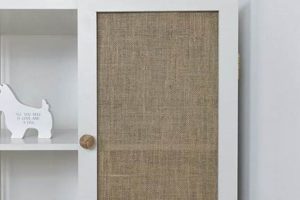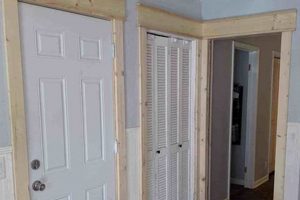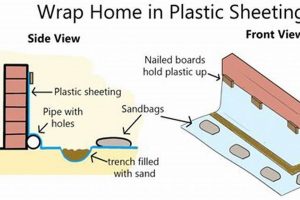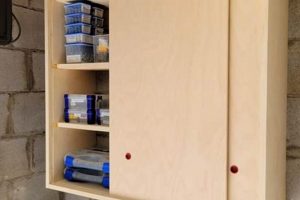A do-it-yourself folding door represents a cost-effective and space-saving solution for interior partitions. These doors typically consist of vertical panels connected by hinges, allowing them to collapse into a compact stack when open. An example application includes dividing a large room into smaller, more functional areas or providing access to closets or storage spaces where a traditional swinging door would be impractical.
Implementing such a door offers several advantages, primarily in areas with limited clearance or a need for flexible space management. They can also contribute to energy efficiency by isolating sections of a building. The concept of a dividing partition dates back centuries, with early examples found in Japanese and Chinese architecture. Modern iterations leverage materials like PVC, wood, and composite materials, providing diverse aesthetic options.
The subsequent sections will delve into the various aspects of planning, constructing, and installing these space-efficient doors, including material selection, measurement techniques, assembly procedures, and troubleshooting common issues, providing a foundation for successfully executing such projects.
Tips for a Successful Folding Partition Installation
This section provides essential guidance to ensure a successful project outcome when installing a folding partition. Adhering to these suggestions will minimize complications and optimize the functionality and longevity of the finished installation.
Tip 1: Accurate Measurement is Paramount: Precise measurement of the opening is critical. Discrepancies, even minor ones, can lead to functional issues and aesthetic imperfections. Measure the width and height at multiple points to account for any variations in the opening’s dimensions.
Tip 2: Material Selection Impacts Durability: The chosen material influences the lifespan and suitability of the divider. PVC is a budget-friendly and moisture-resistant option, whereas wood or composite materials offer enhanced aesthetics and structural integrity. Consider the environment and usage frequency when selecting materials.
Tip 3: Hardware Quality Ensures Smooth Operation: Invest in high-quality hardware, including tracks, rollers, and hinges. Inferior components can result in noisy operation, sticking, and premature failure. Select hardware designed to withstand the weight and anticipated usage of the divider.
Tip 4: Proper Alignment Prevents Binding: Correct alignment during installation is essential to prevent binding and ensure smooth, effortless operation. Use a level to verify that the top track is perfectly horizontal and that the panels are plumb. Misalignment is a primary cause of operational difficulties.
Tip 5: Adequate Support Maximizes Stability: Ensure sufficient structural support for the top track, particularly in wider openings. Reinforce the mounting surface as needed to prevent sagging or detachment over time. Insufficient support can compromise the stability and functionality of the entire installation.
Tip 6: Lubrication Reduces Friction: Apply lubricant to the moving parts, such as rollers and hinges, to minimize friction and ensure quiet operation. Use a silicone-based lubricant designed for the specific materials used in the divider. Regular lubrication will extend the lifespan of the components.
Tip 7: Follow Manufacturer’s Instructions: Always adhere strictly to the manufacturer’s instructions for assembly and installation. Deviations from the recommended procedures can void warranties and compromise the structural integrity of the divider. Consult the instructions throughout the entire process.
These recommendations emphasize precision, material quality, and attention to detail as crucial factors for a successful project. Implementing these tips will result in a functional, aesthetically pleasing, and long-lasting folding partition installation.
The next section will address potential troubleshooting scenarios and offer practical solutions to address common challenges encountered during the installation process.
1. Accurate Measurement
Accurate measurement constitutes a foundational element in the successful execution of a do-it-yourself folding partition installation. Inaccurate measurements introduce a cascade of potential problems, culminating in a non-functional or aesthetically displeasing result. The dimensions of the opening must be precisely determined to ensure the partition fits correctly within the designated space. If measurements are too small, gaps will exist, compromising privacy and potentially affecting insulation. Conversely, if measurements are too large, the partition may not fit at all, necessitating costly adjustments or a complete rework. A common scenario involves misjudging the width of the opening, leading to panels that are either too wide to fully collapse or too narrow to provide adequate coverage.
The practical significance of accurate measurement extends beyond the initial installation phase. A well-fitted partition operates smoothly, minimizing wear and tear on the hardware and prolonging the lifespan of the entire system. Consider the case of a closet divider: if the height measurement is slightly off, the bottom edge of the partition could drag along the floor, causing premature damage and hindering its operation. Similarly, an inaccurate width measurement can result in panels binding against each other, making them difficult to open and close. Precision is crucial when ordering pre-cut materials or fabricating custom panels, as even minor errors can compound during the assembly process. Utilizing appropriate measuring tools, such as a reliable tape measure and a level, is therefore essential.
In summary, the linkage between accurate measurement and a successfully installed folding partition is direct and unequivocal. Neglecting this critical step introduces significant risks, potentially leading to increased costs, wasted materials, and functional limitations. Meticulous attention to detail during the measurement phase is an investment that pays dividends in the form of a durable, aesthetically pleasing, and efficiently functioning partition. The initial investment in accurate measurement techniques can save considerable time, money, and frustration in the long run, ensuring the desired outcome is achieved.
2. Material Selection
The selection of appropriate materials is a critical determinant of the final performance and longevity of a do-it-yourself folding partition. The choice of materials impacts not only the aesthetic appeal of the installation but also its durability, functionality, and overall suitability for the intended environment. Careful consideration of material properties is therefore paramount.
- PVC Panels
Polyvinyl chloride (PVC) panels offer a cost-effective and moisture-resistant option. Their resistance to water damage makes them suitable for use in bathrooms, kitchens, or basements. However, PVC panels may lack the aesthetic appeal of natural wood or other materials. Their durability is generally lower compared to wood or metal, and they may be susceptible to cracking or warping under extreme temperature fluctuations. A real-world example includes using PVC panels in a laundry room to partition off the washing machine area.
- Wood and Wood Composites
Wood or wood composite materials, such as plywood or MDF, provide greater aesthetic flexibility and can be stained or painted to match existing dcor. Wood offers a natural look and feel but is susceptible to moisture damage and requires proper sealing. Composites offer improved resistance to moisture compared to solid wood but may lack the structural integrity of hardwoods. An example is utilizing a stained pine partition in a living room to create a temporary office space.
- Metal Panels
Metal panels, typically aluminum or steel, offer superior durability and resistance to impact damage. They are well-suited for high-traffic areas or environments where resistance to wear and tear is essential. However, metal panels can be more expensive and may require specialized tools for cutting and installation. They can also be prone to denting or scratching if not properly treated. A commercial application could involve employing aluminum panels to divide a warehouse space.
- Hardware Components
The material composition of hardware components, such as hinges, rollers, and tracks, significantly influences the smooth operation and overall lifespan of the partition. Using low-quality hardware can result in premature failure, noisy operation, and difficulty opening and closing the partition. Choosing durable materials like stainless steel or high-grade plastics for hardware components is crucial for ensuring reliable performance over time. For example, selecting steel rollers with ball bearings will contribute to smoother and quieter operation compared to plastic rollers.
These material options present a spectrum of trade-offs between cost, durability, aesthetics, and ease of installation. The optimal selection is contingent upon the specific application, budget constraints, and desired aesthetic. Ultimately, a well-informed decision regarding material composition will contribute significantly to the overall success and satisfaction derived from the resulting folding partition.
3. Hardware Quality
Hardware quality is a critical, often underestimated, factor in the successful implementation and long-term performance of a do-it-yourself folding partition. The components selected dictate not only the ease of installation but also the smoothness of operation, durability, and overall lifespan of the completed structure. Compromising on hardware quality can lead to operational difficulties, premature failure, and ultimately, the need for costly repairs or replacements.
- Track System Integrity
The track system serves as the foundation for the door’s movement. Its integrity directly impacts the ease with which the partition opens and closes. Inadequate track strength can lead to sagging, binding, and ultimately, failure. For example, a lightweight aluminum track may be insufficient for a heavy wood panel, resulting in operational difficulties and potential structural damage. Conversely, a robust steel track ensures smooth gliding and long-term stability.
- Roller and Hinge Durability
Rollers and hinges are the moving parts that enable the accordion-style folding action. Their durability directly affects the smoothness and quietness of operation. Low-quality rollers can develop flat spots, causing jerky movement and increased noise. Flimsy hinges can bend or break under stress, compromising the integrity of the entire partition. For instance, using ball-bearing rollers with durable hinges will significantly improve the user experience compared to basic plastic components.
- Locking Mechanism Reliability
The locking mechanism provides security and ensures the partition remains closed when desired. An unreliable locking system can fail to engage properly, leaving the partition vulnerable to unwanted opening. A sturdy latch or bolt made from durable materials is essential for providing a secure closure. Consider a scenario where a flimsy plastic latch breaks easily, rendering the partition ineffective for privacy or security.
- Material Corrosion Resistance
The hardware’s resistance to corrosion is particularly important in environments with high humidity or exposure to moisture. Components made from non-corrosive materials, such as stainless steel or coated metals, will resist rust and degradation, ensuring long-term performance. Using standard steel hardware in a bathroom, for example, will likely lead to corrosion and eventual failure, while stainless steel hardware will maintain its functionality and appearance over time.
These interconnected elements highlight the importance of prioritizing hardware quality when constructing a space-saving partition. Neglecting this aspect can lead to functional limitations, decreased lifespan, and ultimately, dissatisfaction with the end product. Investing in high-quality hardware translates to a durable, smoothly operating, and reliable folding partition that enhances the functionality and aesthetic appeal of the space.
4. Proper Installation
Proper installation is inextricably linked to the functionality and longevity of a do-it-yourself folding partition. It represents the culmination of careful planning, accurate measurement, and judicious material selection. A partition, regardless of the quality of its components, will fail to perform adequately if improperly installed. The ramifications of flawed installation range from operational difficulties, such as binding or misalignment, to structural instability, potentially leading to premature failure. Consider the scenario where a divider is intended to create a private workspace within a larger room; improper installation, resulting in gaps or instability, negates the intended purpose. The practical significance of this understanding lies in recognizing installation as a critical determinant of success.
The correlation between correct installation techniques and the partition’s operational effectiveness is demonstrable across various aspects. For example, ensuring the track is perfectly level is paramount to smooth gliding. An uneven track will cause panels to bind or drag, significantly increasing friction and wear. Similarly, proper alignment of the panels is crucial for uniform folding and closure. Misaligned panels can create gaps and impede the locking mechanism. Real-world applications highlight these dependencies; a closet partition with a track not securely fastened to the wall will likely detach over time, rendering the partition unusable. Correctly anchoring the track to studs or using appropriate wall anchors is vital to prevent such occurrences.
In summary, the installation phase dictates the ultimate success or failure of the project. It demands meticulous attention to detail, adherence to manufacturer specifications, and a thorough understanding of basic construction principles. Challenges such as uneven surfaces, non-standard openings, or inadequate structural support necessitate careful problem-solving and adaptation. The ability to accurately assess and address these challenges is essential for achieving a functional, aesthetically pleasing, and durable folding partition. Proper installation, therefore, transcends mere assembly; it represents a synthesis of knowledge, skill, and meticulous execution, ultimately determining the value and utility of the constructed partition.
5. Space Optimization
The inherent value of a do-it-yourself folding partition lies in its capacity for space optimization. This relationship represents a fundamental principle: the partitions design directly addresses the need to maximize usable area, particularly in constrained environments. The cause is limited square footage, and the effect is the employment of a folding partition as a spatial solution. Space optimization is not merely an incidental benefit but a core component of the partition’s functionality; its design inherently prioritizes efficient use of available space. For example, in a small apartment, a folding partition can effectively separate a living area from a bedroom without requiring the swing space of a conventional door, thereby reclaiming valuable floor area.
The practical application of this understanding extends to diverse settings. In a home office, a folding partition allows for the creation of a temporary meeting space, which can be quickly retracted to restore the room to its original dimensions. Similarly, in a retail environment, such partitions can be used to divide a larger area into smaller, more manageable zones for product display or customer service. A key challenge in achieving effective space optimization lies in the selection of appropriate materials and dimensions to ensure the partition functions as intended without visually overwhelming the space. The balance between practicality and aesthetics is crucial to realizing the full potential of a space-saving design.
In conclusion, space optimization is intrinsically linked to the purpose and design of a folding partition. Its effectiveness hinges on careful consideration of the spatial needs, material selection, and installation techniques. Overcoming challenges in balancing functionality and aesthetics ultimately leads to a more efficient and adaptable living or working environment. The partition, therefore, serves as a tangible representation of the principles of efficient space management and adaptive design, enhancing the usability and value of the available square footage.
Frequently Asked Questions
This section addresses common inquiries regarding the planning, construction, and installation of do-it-yourself folding partitions, providing clear and concise answers to ensure a successful project.
Question 1: What is the typical cost associated with building such a door?
The expense varies considerably depending on material selection, dimensions, and hardware quality. Budget-conscious options utilizing PVC panels and basic hardware may cost significantly less than custom-built wood partitions with premium components. A thorough cost analysis encompassing all materials and tools is essential before commencing the project.
Question 2: Are specialized tools required for installation?
While basic tools such as a tape measure, level, screwdriver, and drill are typically sufficient, specific tasks may necessitate specialized equipment. Cutting certain materials, such as metal, may require a specialized saw or cutting tool. Consult material manufacturers recommendations for specific tool requirements.
Question 3: How does one ensure proper alignment during installation?
Employ a level to verify the horizontal alignment of the track system and a plumb bob or level to ensure vertical alignment of the panels. Precise alignment is critical to prevent binding and ensure smooth operation. Correcting alignment issues after installation can be challenging; therefore, meticulous attention to detail during the initial setup is paramount.
Question 4: What are the common causes of operational difficulties, such as sticking or binding?
Misalignment, inadequate lubrication, and inferior hardware are frequent contributors to operational issues. Ensure the track is level, panels are plumb, and all moving parts are adequately lubricated. Upgrading to higher-quality hardware, particularly rollers and hinges, can often resolve recurring problems.
Question 5: How does the choice of material impact the long-term durability of the door?
The selected material dictates the partition’s resistance to wear, moisture, and impact damage. PVC offers moisture resistance but may lack structural strength. Wood provides aesthetic appeal but requires proper sealing. Metal offers superior durability but can be more expensive. Evaluating the intended environment and usage patterns is essential for material selection.
Question 6: What maintenance procedures are recommended to prolong the lifespan of the partition?
Regular cleaning and lubrication of moving parts are crucial for maintaining optimal performance. Dust and debris can accumulate in the track system, impeding smooth operation. Applying a silicone-based lubricant to rollers and hinges reduces friction and prevents premature wear. Periodically inspect hardware for loose screws or signs of corrosion and address any issues promptly.
These FAQs provide foundational knowledge for addressing common concerns related to folding partitions. Adhering to these guidelines enhances the likelihood of a successful and enduring installation.
The subsequent section will examine potential troubleshooting scenarios and offer practical solutions to address common challenges encountered during the installation process.
Concluding Remarks on Space-Efficient Partitions
This article has provided a comprehensive examination of do-it-yourself folding partitions, encompassing planning, material selection, installation techniques, and maintenance considerations. The exploration has emphasized the critical roles of accurate measurement, hardware quality, and proper alignment in achieving a functional and aesthetically pleasing result. The discussion has also addressed common challenges and provided practical solutions to ensure successful implementation. The overarching theme has been the optimization of space through informed decision-making and meticulous execution.
The information presented serves as a foundation for those undertaking such projects. A thorough understanding of the principles outlined herein will contribute to informed decision-making, mitigating potential challenges and maximizing the value derived from a space-saving partition. Further research into specific material properties and advanced installation techniques is encouraged to refine individual approaches and enhance the longevity of completed projects.







